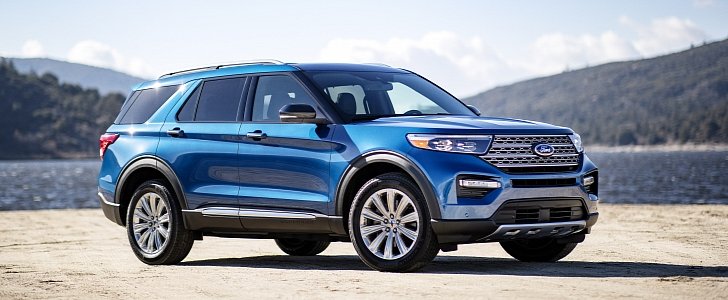Based on the Limited trim level, the rear-wheel-drive 2020 Ford Explorer Hybrid is estimated at 28 miles per gallon on the combined cycle. The Environmental Protection Agency’s ratings for city and highway driving are 27 and 29 miles per gallon, respectively.
Thanks to an 18-gallon fuel tank, the total range the Explorer Limited Hybrid RWD promises between fill-ups is 504 miles, at least in theory. Why aren’t these numbers impressive, you wonder? Take the Toyota Highlander Hybrid as the golden standard, delivering 29 miles to the gallon on the combined driving cycle. Worse still for the Ford Motor Company, the Highlander Hybrid LE Plus features an all-wheel drive system.
The Toyota can also achieve up to 557 miles of total range, which goes to show that the Explorer Hybrid could do better. All in all, pretty unimpressive given that the mid-size SUV has been redesigned from the ground up for the 2020 model year. What Ford does have going for it is towing capacity. At 5,000 pounds (2,268 kilograms) for the hybrid powertrain, the Toyota plays second fiddle with a deficit of 1,500 pounds.
Only available in Limited specification, the Explorer Hybrid relies on a 3.3-liter naturally aspirated V6 and a 35-kilowatt electric motor connected to a 1.5-kWh battery. If you head on over to the Ford configurator for the U.S. market, you’ll notice the F-150 featured the engine as the entry-level option with 290 horsepower and 265 pound-feet.
The Explorer Hybrid levels up to 318 horsepower and 322 pound-feet of torque, and that’s comparable to the entry-level EcoBoost four-cylinder turbo with 300 horsepower and 310 pound-feet on tap. The 3.0-liter EcoBoost twin-turbo V6 serves as the range-topping option.
Coincidence or not, the most powerful engine of the lot is also the most thirsty at 20 miles to the gallon combined (18 mpg in the city and 24 mpg out on the highway). The Explorer ST is good for 400 horsepower and 415 pound-feet of torque, and like the other engines, a 10-speed automatic transmission does the shifting.
The Toyota can also achieve up to 557 miles of total range, which goes to show that the Explorer Hybrid could do better. All in all, pretty unimpressive given that the mid-size SUV has been redesigned from the ground up for the 2020 model year. What Ford does have going for it is towing capacity. At 5,000 pounds (2,268 kilograms) for the hybrid powertrain, the Toyota plays second fiddle with a deficit of 1,500 pounds.
Only available in Limited specification, the Explorer Hybrid relies on a 3.3-liter naturally aspirated V6 and a 35-kilowatt electric motor connected to a 1.5-kWh battery. If you head on over to the Ford configurator for the U.S. market, you’ll notice the F-150 featured the engine as the entry-level option with 290 horsepower and 265 pound-feet.
The Explorer Hybrid levels up to 318 horsepower and 322 pound-feet of torque, and that’s comparable to the entry-level EcoBoost four-cylinder turbo with 300 horsepower and 310 pound-feet on tap. The 3.0-liter EcoBoost twin-turbo V6 serves as the range-topping option.
Coincidence or not, the most powerful engine of the lot is also the most thirsty at 20 miles to the gallon combined (18 mpg in the city and 24 mpg out on the highway). The Explorer ST is good for 400 horsepower and 415 pound-feet of torque, and like the other engines, a 10-speed automatic transmission does the shifting.























































